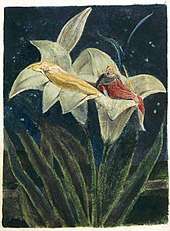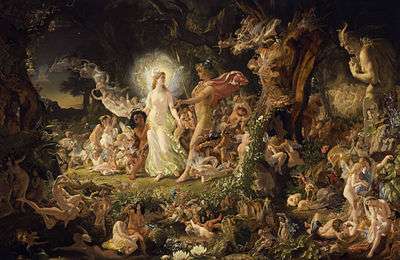Titania
Titania (/tɪˈtɑːniə/)[1] is a character in William Shakespeare's 1595–1596 play A Midsummer Night's Dream. In the play, she is the queen of the fairies. Due to Shakespeare's influence, later fiction has often used the name "Titania" for fairy queen characters.

Overview
In traditional folklore, the fairy queen has no name. Shakespeare took the name "Titania" from Ovid's Metamorphoses, where it is an appellation given to the daughters of Titans.[2]
Shakespeare's Titania is a very proud creature and as much of a force to contend with as her husband, Oberon. She and Oberon are engaged in a marital quarrel over which of them should have the keeping of an Indian changeling boy. This quarrel is the engine that drives the mix-ups and confusion of the other characters in the play. Due to an enchantment cast by Oberon's servant Puck, Titania magically falls in love with a "rude mechanical" (a labourer), Nick Bottom the weaver, who has been given the head of a donkey by Puck, who feels it is better suited to his character. It has been argued that this incident is an inversion of the Circe story.[3] In this case, the tables are turned on the character and rather than the sorceress turning her lovers into animals, she is made to love a donkey after Bottom has been transformed.
Legacy
Titania has appeared in many other paintings, poems, plays and other works.
- Johann Wolfgang von Goethe included the figures from Shakespeare's work in Faust I, where she and her husband are celebrating their golden wedding anniversary.
- Carl Maria von Weber used the characters of Titania, Oberon and Puck in his opera Oberon, but this time set during the reign of Charlemagne.
- Titania appears in the Shin Megami Tensei series of video games as a recruitable Demon alongside her spouse Oberon.
- Alfred Lord Tennyson's play The Foresters, which is a Robin Hood story, has a brief segment with Titania, Queen of the Fairies.
- Titania, one of Uranus's moons, was named after her.
- Titania appears in the popular online game Warframe as the namesake of one of the titular Warframes, featuring razor-butterflies and assorted fairy-themed abilities.[4]
- In the manga and anime The Ancient Magus' Bride (魔法使いの嫁 Mahō Tsukai no Yome) the Queen of the Fairies is named Titania. Her husband Oberon also appears.
- In the manga and anime Fairy Tail, Erza Scarlet carries the title of "Titania, Queen of the Fairies" because of her status as the most powerful of the female wizards in the Fairy Tail guild.
- In the cartoon Gargoyles, Oberon and Titania have been divorced for 1,001 years, but remarry during the course of the series. She is eventually also revealed to be the same person as Anastasia Renard, mother of the recurring antagonist Fox.
- Titania is the one of the bases for one of the bosses in Mega Man Zero 4, Sol Titanion, alongside an Atlas moth.
- Titania is the queen of the Summer Court of fairies in Jim Butcher's The Dresden Files series.
- In W.E.B. Du Bois's Dark Princess, the author dedicates the book to, "To her High Loveliness, Titania XXVII...Queen of Faerie."
- In Final Fantasy XIV: Shadowbringers, Titania appears as an opponent during the course of the story. In the fiction, the name "Titania" is actually a title held by the ruler of the faeries rather than a name in itself.
- In the light novel series and anime Sword Art Online, main female protagonist Asuna Yuuki is trapped in the virtual fairy world of ALfhiem Online by Nobuyuki Suguo, calling himself Oberon and calling Asuna by the name of Titania.
- In Vertigo Comics' The Sandman, Titania rules Faerie with her mate Auberon and is a rumored one-time lover of the titular Lord of Dreams. One issue actually presents that Will Shakespeare created A Midsummer Night's Dream as a commission piece for Dream—who presents it to Titania as a gift to Faerie, so that the fey folk should not be forgotten in the Waking World.
 One of William Blake's illustration to his The Song of Los. Scholars have traditionally identified the figures as Titania and Oberon, though not all new scholarship does.[5] This copy, currently held by the Library of Congress, was printed and painted in 1795.[6]
One of William Blake's illustration to his The Song of Los. Scholars have traditionally identified the figures as Titania and Oberon, though not all new scholarship does.[5] This copy, currently held by the Library of Congress, was printed and painted in 1795.[6] The Quarrel of Oberon and Titania, by Joseph Noel Paton, c. 1849
The Quarrel of Oberon and Titania, by Joseph Noel Paton, c. 1849
References
- Titania, Lexico/OED. Only the first pronunciation is used in productions of A Midsummer Night's Dream, e.g. Shakespeare Recording Society (1995) The Tempest (audio CD).
- Holland, Peter, ed. A Midsummer Night's Dream (OUP, 1994)
- Paul A. Olson, Beyond a Common Joy: An Introduction to Shakespearean Comedy, University of Nebraska 2008, pp. 79–82
- "Warframe Titania". warframe.com. Digital Extremes. Retrieved 1 December 2016.
- Morris Eaves; Robert N. Essick; Joseph Viscomi (eds.). "Description of 'The Song of Los, copy B, object 5 (Bentley 5, Erdman 5, Keynes 5)'". William Blake Archive. Retrieved January 27, 2013.
- Morris Eaves; Robert N. Essick; Joseph Viscomi (eds.). "The Song of Los, copy B, object 5 (Bentley 5, Erdman 5, Keynes 5)". William Blake Archive. Retrieved January 27, 2013.